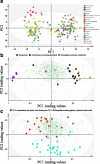A pilot study comparing the metabolic profiles of elite-level athletes from different sporting disciplines
- PMID: 29305667
- PMCID: PMC5756230
- DOI: 10.1186/s40798-017-0114-z
A pilot study comparing the metabolic profiles of elite-level athletes from different sporting disciplines
Abstract
Background: The outstanding performance of an elite athlete might be associated with changes in their blood metabolic profile. The aims of this study were to compare the blood metabolic profiles between moderate- and high-power and endurance elite athletes and to identify the potential metabolic pathways underlying these differences.
Methods: Metabolic profiling of serum samples from 191 elite athletes from different sports disciplines (121 high- and 70 moderate-endurance athletes, including 44 high- and 144 moderate-power athletes), who participated in national or international sports events and tested negative for doping abuse at anti-doping laboratories, was performed using non-targeted metabolomics-based mass spectroscopy combined with ultrahigh-performance liquid chromatography. Multivariate analysis was conducted using orthogonal partial least squares discriminant analysis. Differences in metabolic levels between high- and moderate-power and endurance sports were assessed by univariate linear models.
Results: Out of 743 analyzed metabolites, gamma-glutamyl amino acids were significantly reduced in both high-power and high-endurance athletes compared to moderate counterparts, indicating active glutathione cycle. High-endurance athletes exhibited significant increases in the levels of several sex hormone steroids involved in testosterone and progesterone synthesis, but decreases in diacylglycerols and ecosanoids. High-power athletes had increased levels of phospholipids and xanthine metabolites compared to moderate-power counterparts.
Conclusions: This pilot data provides evidence that high-power and high-endurance athletes exhibit a distinct metabolic profile that reflects steroid biosynthesis, fatty acid metabolism, oxidative stress, and energy-related metabolites. Replication studies are warranted to confirm differences in the metabolic profiles associated with athletes' elite performance in independent data sets, aiming ultimately for deeper understanding of the underlying biochemical processes that could be utilized as biomarkers with potential therapeutic implications.
Keywords: Elite athletes; Endurance; Energy substrates; Metabolomics; Oxidative stress; Power; Steroids biosynthesis.
Conflict of interest statement
Authors’ information
CG and FB are directors of anti-doping labs in Qatar and Italy, respectively. ID, KS, and NY are the bioinformatics/biostatistics team. MAE is the lead PI.
Ethics approval and consent to participate
This study was performed in line with the World Medical Association Declaration of Helsinki. Only consented participants were included in the study. All protocols were approved by the Institutional Research Board of anti-doping lab Qatar (F2014000009).
Consent for publication
Not applicable
Competing interests
Fatima Al-Khelaifi, Ilhame Diboun, Francesco Donati, Francesco Botrè, Mohammed Alsayrafi, Costas Georgakopoulos, Karsten Suhre, Noha A. Yousri, and Mohamed A Elrayess declare that they have no competing interests.
Publisher’s Note
Springer Nature remains neutral with regard to jurisdictional claims in published maps and institutional affiliations.
Figures






References
-
- Yan B, A J, Wang G, Lu H, Huang X, Liu Y et al. Metabolomic investigation into variation of endogenous metabolites in professional athletes subject to strength-endurance training. J Appl Physiol 2009;106(2):531-538. doi:10.1152/japplphysiol.90816.2008. - PubMed
Grants and funding
LinkOut - more resources
Full Text Sources
Other Literature Sources

